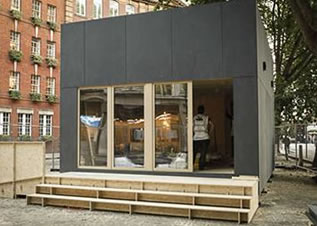
Can 3D printing end the housing crisis and even be used to colonise the moon?
Pictures of Wikihouse 4.0 courtesy of photographer Margaux Carron
As the worlds first flat-pack, affordable Wikihouse 4.0 officially opened to the public this week as part of the London Design Festival, the benefits of using 3D printing in construction are becoming more accepted amongst industry professionals, who believe that the method could be used to end the housing crisis currently being experienced across large parts of the UK.
Constructed over a period of eight days at a cost of just andpound;50,000, Wikihouse is a two-storey, two bedroom property designed with CAD software and with no real help from professional builders or architects during the design or construction.
Wikihouse is not the first home to be constructed using 3D printing; Dutch architects are currently in the process of building a full sized printed house that is waste free, eco friendly and mainly designed using a plastic based on plant oil. Whilst a Shanghai based engineering company built 10 full sized homes in 24 hours using a giant 3D printer, at a cost of less than andpound;3,000 each.
Nasa is also working with Dr Behrokh Khoshnevis of Contour Crafting, who aims to create a Martian settlement on the moon by 3D printing concrete buildings layer by layer, using a giant robotic printer and lunar rock.
The companys construction systems are being developed in order to utilise lunar regolith as a building material and create structures that include integrated radiation shielding, plumbing, electrical and sensor networks.
Contour Craftings technology can also be put into practice to construct a 2,000 square foot house with utilities for electrical and plumbing in less than 24 hours, designed for people needing emergency housing in the aftermath of a hurricane, earthquake or tsunami – a quick-fix technique which the industry desperately needs should any more natural disasters occur.
Over in the car manufacturing industry, Le Mans car designers also turned to 3D printing in order to test out their designs recently; whilst the futuristic car, Strati, was created in just 44 hours using 40 parts and direct digital manufacturing techniques.
3D printing allows anyone with access to a specialised printer to create anything they want. Although there are certain limitations to what can be printed in terms of materials and size constraints, the technology has endless possibilities for the world of architecture and design in general.
Latest news

22nd November 2024
Insight Data: Using Marketing Data to Build a Successful Business in 2025
Alex Tremlett, Insight Data’s Commercial Director, discusses the challenges for construction firms in 2025 and shares six strategies for success…
Posted in Articles, Building Industry News, Building Services, Information Technology, news, Research & Materials Testing
22nd November 2024
Purplex: A tough Budget, but opportunity still knocks
Incoming governments, especially those with significant mandates, inevitably come into power on a tidal wave of optimism coupled with hope that ‘Things can only get better’. Andrew Scott, MD of construction-focused, full-service agency Purplex, talks…
Posted in Articles, Building Industry News, Building Services, Information Technology, news, Posts, Research & Materials Testing
22nd November 2024
Pop Up Power Supplies Gets Arty in Yorkshire
Pop Up Power Supplies has installed 13 new electricity units at The Hepworth Wakefield – read more in this article…
Posted in Articles, Building Industry News, Building Products & Structures, Building Services, Case Studies, Civil Engineering, Facility Management & Building Services, Garden, Hard Landscaping & Walkways, Landscaping, Posts, Restoration & Refurbishment, Retrofit & Renovation
22nd November 2024
OPT Services Revolutionises Fibre Cable Capping with Eco-Friendly Innovation
UK-based OPT Services has unveiled SlimLine™ Capping, a groundbreaking fibre cable protection solution that promises to deliver significant environmental and installation advantages to the fibre optic industry.
Posted in Articles, Building Industry News, Building Products & Structures, Building Services, Facility Management & Building Services, Information Technology, Innovations & New Products, Sustainability & Energy Efficiency
 Sign up:
Sign up: